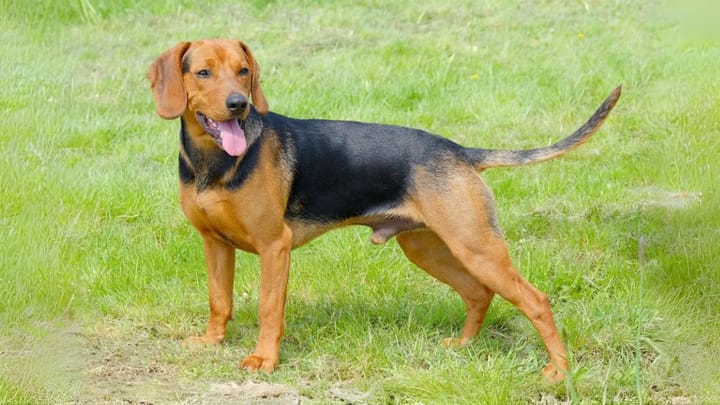Serbian Hound
Other names : Balkan Hound, Srpski gonič, Balkanski gonič

The Serbian Hound is often also called the Balkan Hound. These dogs are used as scent hounds in Montenegro and Serbia. The medium-sized, prized hunting dog has a loyal, kind and willing nature. They thrive in the hunting field and they also make wonderful companion pets for the home. Not only are they very trustworthy, but they are excellent playmates for children.
|
Life expectancy |
The Serbian Hound has a life expectancy of between 11 and 13 years |
|
Temperament |
|
|
Size |
Medium
|
|
Adult size |
Female
Between 17 and 21 in
Male
Between 18 and 22 in
|
|
Adult weight |
Female
Between 44 and 49 lb
Male
Between 44 and 49 lb
|
|
Coat colour
Red, Yellow, Red/Yellow and Rust. The majority of Serbian Hounds also have a black saddle from the base of their head to their back, with striking black marks above the eyebrow line. Some have a white spot on their chest. |
Black Red |
|
Type of coat
The Serbian Hound has a typical short, hound-like coat with a harsh top coat and a well-developed undercoat. |
Short |
|
Eye colour
Brown. |
Brown
|
|
Purchase price |
The Serbian Hound costs between £400 and £600 |
This vigorous hunting dog, who is also known for his lively and gentle nature, also makes a marvellous companion dog. Although he is quite common in his native homeland, it is very rare to see a Serbian Hound in other locations. It can be quite difficult to locate a breeder and because of this, there can be a long waiting list to become an owner.
More details about the Serbian Hound
Serbian Hound: Origins and history
This ancient breed of hound dates back to the 11th century. Serbian Hounds have always been used as hunting and scenting dogs. History claims that the breed has canine relatives from Asia Minor, or even from Egypt, as Phoenician traders were thought to own Balkan Hounds around 1000BC. Previously called the Balkan Hound, the name was changed to the Serbian Hound in 1996 by the FCI. Today, this breed is very rarely seen outside of Montenegro, Serbia and other Balkan regions and almost never in the United Kingdom.
Physical characteristics of the Serbian Hound
It’s noticeable with this breed, that the males are a larger size than the females. The Serbian Hound is an attractive dog, well-muscled with an athletic build. His head appears slightly rounded in shape, with medium length ears that are set high, with oval tips. They hang down, close to the dog’s cheeks. This hound holds his neck in an arched position which only improves his athletic appearance. The dog has powerful, muscled hind-quarters and a tail that is held raised, but not too high.
FCI classification of the Serbian Hound
-
Group 6 - Scent hounds and related breeds
-
Section 1 : Scent hounds
Serbian Hound: Characteristics
Serbian Hound: Behaviour
Training a Serbian Hound
This hound will form ties with his master and adores this one-to-one attention. They really are a joy to train. The Serbian Hound is always eager to please, especially if it involves new routines.
Serbian Hound: Lifestyle
Breed compatibility Serbian Hound
Serbian Hound: Purchase price
The initial cost to purchase a Serbian Hound puppy will be between £400 and £600. In addition, a monthly budget of £80 to £120 will be needed to cover food, vet’s bills, and pet insurance.
Serbian Hound: Grooming
This dog is quite low maintenance when it comes to grooming routines, even though he sheds hair steadily through the seasons.
Serbian Hound: Health
Generally, the Serbian Hound is a robust and healthy scent hound. Its average life expectancy is 11 to 13 years.
These canines have a strong work ethic and ongoing stamina, especially when hunting.
No problems when working or living in warmer climates for this dog.
When scenting for his prey, this hound will have no issues over difficult terrains or in cooler weather conditions.
Just as with many other breeds of working dogs, when they cease work, or have been neutered or spayed, they tend to gain weight.


